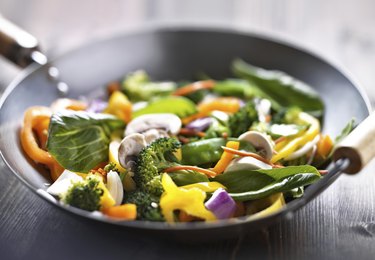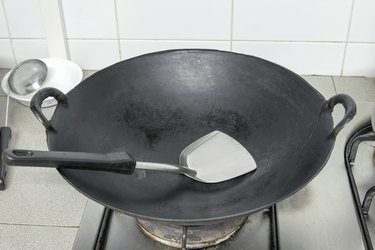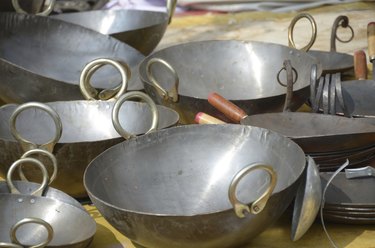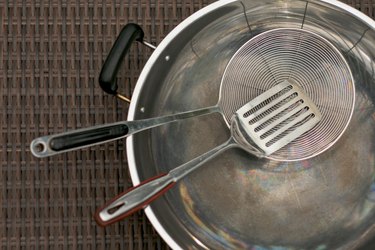
There is considerable debate over the desirability of stainless steel woks versus the traditional carbon steel woks that have been used for centuries. Traditionalists and most professional chefs turn up their noses at the idea of using stainless steel woks for several reasons. But opinions are like noses–everybody's got one.
Carbon Steel
Video of the Day

Carbon steel is a tried and true material that has served generation upon generation, particularly in the Asian, where cooks use nothing but hand-hammered carbon steel works for many reasons. For one, they have thicker bottoms that heat to the extremely high temperatures to quickly stir fry foods, while keeping food warm (without further cooking) on the curved sides until it is time to be reintroduced to the main mix.
Video of the Day
Stainless Steel

The most common complaint about stainless steel is that it is thinner, doesn't heat as evenly as carbon steel and develops hot spots. It also requires more oil than the traditional wok and because of its inherent cooking shortcomings. If someone invests in a stainless steel wok, it should be top of the line. In other words, it will be much more expensive than a traditional wok, or, conversely, will not perform as well as a carbon steel wok.
Your Grandmother's Pots and Pans

Before stainless steel and Teflon coated nonstick pans were developed, our grandparents and their grandparents cooked using cast iron skillets. The food didn't stick, the pans heated uniformly because they were heavily constructed and, most importantly, they were seasoned. Seasoning cast iron is the same as seasoning a carbon steel wok. It simply means filling the pores and voids in the metal with grease of some sort, which cooks into the pan or wok, creating a smooth, nonstick surface. Because of the way stainless steel woks are made, no seasoning is required but it will miss the “magic” that your grandmother's food always had.
How to Season

It takes less than 30 minutes to season a wok. You must season the wok before you use it the first time to remove the manufacturing oils and to prevent rust. It's a simple process. Heat a few drops of oil in the pan at high heat until smoking. Remove, let cool and then wipe clean. Do this several times, drying the wok thoroughly, and wipe lightly with a drop or two of oil to prevent rust. You don't have to do this with stainless steel, but you won't impart your grandmother's magic to the pan, either.
Simplicity of Use and Clean-up

For simplicity of use and clean-up (excluding the seasoning), stainless steel woks will perform adequately. If your main concerns are quick and easy use and quick cleanup (even in a dishwasher), then a high-grade stainless steel wok will work fine. If your stove is electric, you might consider using a flat-bottomed wok, but the cooking style will differ from the traditional rounded wok. Also, unlike carbon steel, you can use a steel cleaning pad to clean the wok. Never, ever, uses stainless steel to clean a carbon steel wok. You'll wipe away the magic flavor and will have to season it again.